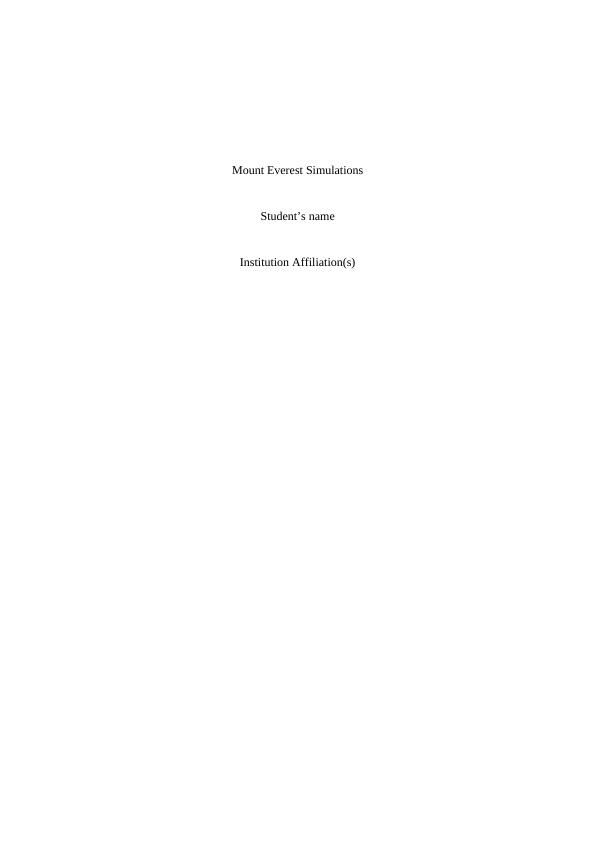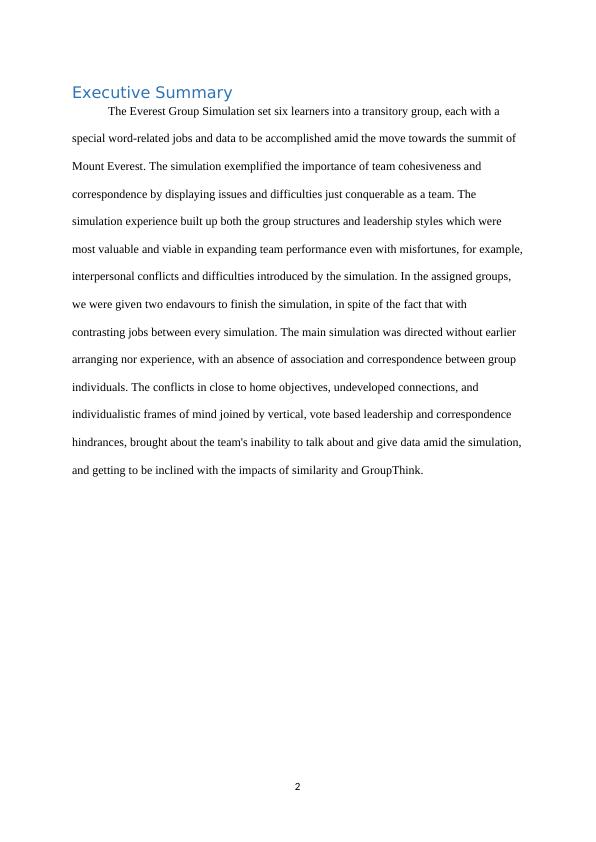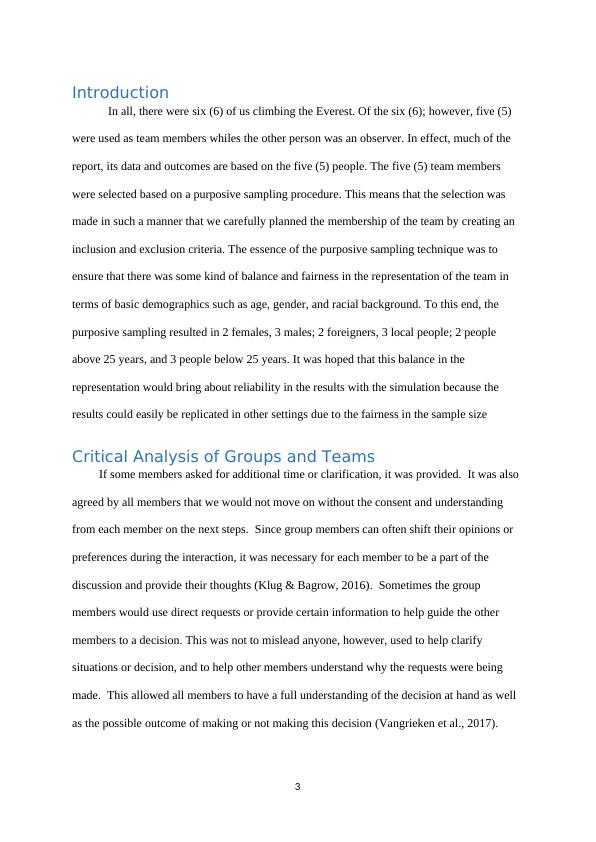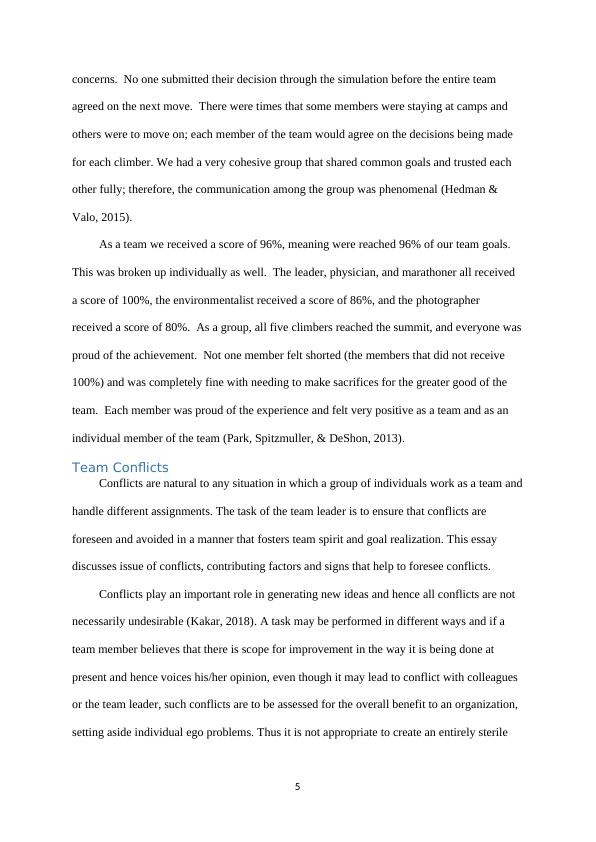Mount Everest Simulations: Critical Analysis of Groups, Leadership, and Conflict Resolution
Critically analyse individual and team experiences in a virtual world and as a physical team using the Harvard Business Publishing Everest simulation, focusing on teams, leadership, and communication. Draw conclusions and provide recommendations for leading projects and being part of a project team.
22 Pages6593 Words485 Views
Added on 2023-06-09
About This Document
This article provides a critical analysis of the groups, leadership, and conflict resolution strategies used in the Mount Everest simulations. It discusses the importance of team building, communication, and conflict resolution in achieving team goals. The article also explores different leadership styles and theories and their effectiveness in team performance.
Mount Everest Simulations: Critical Analysis of Groups, Leadership, and Conflict Resolution
Critically analyse individual and team experiences in a virtual world and as a physical team using the Harvard Business Publishing Everest simulation, focusing on teams, leadership, and communication. Draw conclusions and provide recommendations for leading projects and being part of a project team.
Added on 2023-06-09
ShareRelated Documents
Mount Everest Simulations
Student’s name
Institution Affiliation(s)
Student’s name
Institution Affiliation(s)

Table of Contents
Executive Summary...............................................................................................................................2
Introduction...........................................................................................................................................3
Critical Analysis of Groups and Teams...................................................................................................3
Team Conflicts...................................................................................................................................5
Team Building....................................................................................................................................6
Conflict resolutions............................................................................................................................6
Punctuated equilibrium theory..........................................................................................................7
Critical Analysis of Leadership...............................................................................................................7
Roles of the leader.............................................................................................................................7
Leadership qualities...........................................................................................................................8
Leadership styles...............................................................................................................................8
Contemporary Theories of Leadership..............................................................................................9
Transactional vs. Transformational Leadership Theories...................................................................9
Charismatic Leadership Theories.....................................................................................................10
Trait Leadership Theory...................................................................................................................10
Contingency Theory.........................................................................................................................10
Critical analysis of Communication......................................................................................................11
Challenges and Recommendations......................................................................................................12
Conclusion...........................................................................................................................................13
References...........................................................................................................................................14
Appendices..........................................................................................................................................18
Appendix (i): Simulation 1...............................................................................................................18
Appendix (ii): Simulation 2...............................................................................................................19
Appendix (iii): Team Contract..........................................................................................................20
1
Executive Summary...............................................................................................................................2
Introduction...........................................................................................................................................3
Critical Analysis of Groups and Teams...................................................................................................3
Team Conflicts...................................................................................................................................5
Team Building....................................................................................................................................6
Conflict resolutions............................................................................................................................6
Punctuated equilibrium theory..........................................................................................................7
Critical Analysis of Leadership...............................................................................................................7
Roles of the leader.............................................................................................................................7
Leadership qualities...........................................................................................................................8
Leadership styles...............................................................................................................................8
Contemporary Theories of Leadership..............................................................................................9
Transactional vs. Transformational Leadership Theories...................................................................9
Charismatic Leadership Theories.....................................................................................................10
Trait Leadership Theory...................................................................................................................10
Contingency Theory.........................................................................................................................10
Critical analysis of Communication......................................................................................................11
Challenges and Recommendations......................................................................................................12
Conclusion...........................................................................................................................................13
References...........................................................................................................................................14
Appendices..........................................................................................................................................18
Appendix (i): Simulation 1...............................................................................................................18
Appendix (ii): Simulation 2...............................................................................................................19
Appendix (iii): Team Contract..........................................................................................................20
1

Executive Summary
The Everest Group Simulation set six learners into a transitory group, each with a
special word-related jobs and data to be accomplished amid the move towards the summit of
Mount Everest. The simulation exemplified the importance of team cohesiveness and
correspondence by displaying issues and difficulties just conquerable as a team. The
simulation experience built up both the group structures and leadership styles which were
most valuable and viable in expanding team performance even with misfortunes, for example,
interpersonal conflicts and difficulties introduced by the simulation. In the assigned groups,
we were given two endavours to finish the simulation, in spite of the fact that with
contrasting jobs between every simulation. The main simulation was directed without earlier
arranging nor experience, with an absence of association and correspondence between group
individuals. The conflicts in close to home objectives, undeveloped connections, and
individualistic frames of mind joined by vertical, vote based leadership and correspondence
hindrances, brought about the team's inability to talk about and give data amid the simulation,
and getting to be inclined with the impacts of similarity and GroupThink.
2
The Everest Group Simulation set six learners into a transitory group, each with a
special word-related jobs and data to be accomplished amid the move towards the summit of
Mount Everest. The simulation exemplified the importance of team cohesiveness and
correspondence by displaying issues and difficulties just conquerable as a team. The
simulation experience built up both the group structures and leadership styles which were
most valuable and viable in expanding team performance even with misfortunes, for example,
interpersonal conflicts and difficulties introduced by the simulation. In the assigned groups,
we were given two endavours to finish the simulation, in spite of the fact that with
contrasting jobs between every simulation. The main simulation was directed without earlier
arranging nor experience, with an absence of association and correspondence between group
individuals. The conflicts in close to home objectives, undeveloped connections, and
individualistic frames of mind joined by vertical, vote based leadership and correspondence
hindrances, brought about the team's inability to talk about and give data amid the simulation,
and getting to be inclined with the impacts of similarity and GroupThink.
2

Introduction
In all, there were six (6) of us climbing the Everest. Of the six (6); however, five (5)
were used as team members whiles the other person was an observer. In effect, much of the
report, its data and outcomes are based on the five (5) people. The five (5) team members
were selected based on a purposive sampling procedure. This means that the selection was
made in such a manner that we carefully planned the membership of the team by creating an
inclusion and exclusion criteria. The essence of the purposive sampling technique was to
ensure that there was some kind of balance and fairness in the representation of the team in
terms of basic demographics such as age, gender, and racial background. To this end, the
purposive sampling resulted in 2 females, 3 males; 2 foreigners, 3 local people; 2 people
above 25 years, and 3 people below 25 years. It was hoped that this balance in the
representation would bring about reliability in the results with the simulation because the
results could easily be replicated in other settings due to the fairness in the sample size
Critical Analysis of Groups and Teams
If some members asked for additional time or clarification, it was provided. It was also
agreed by all members that we would not move on without the consent and understanding
from each member on the next steps. Since group members can often shift their opinions or
preferences during the interaction, it was necessary for each member to be a part of the
discussion and provide their thoughts (Klug & Bagrow, 2016). Sometimes the group
members would use direct requests or provide certain information to help guide the other
members to a decision. This was not to mislead anyone, however, used to help clarify
situations or decision, and to help other members understand why the requests were being
made. This allowed all members to have a full understanding of the decision at hand as well
as the possible outcome of making or not making this decision (Vangrieken et al., 2017).
3
In all, there were six (6) of us climbing the Everest. Of the six (6); however, five (5)
were used as team members whiles the other person was an observer. In effect, much of the
report, its data and outcomes are based on the five (5) people. The five (5) team members
were selected based on a purposive sampling procedure. This means that the selection was
made in such a manner that we carefully planned the membership of the team by creating an
inclusion and exclusion criteria. The essence of the purposive sampling technique was to
ensure that there was some kind of balance and fairness in the representation of the team in
terms of basic demographics such as age, gender, and racial background. To this end, the
purposive sampling resulted in 2 females, 3 males; 2 foreigners, 3 local people; 2 people
above 25 years, and 3 people below 25 years. It was hoped that this balance in the
representation would bring about reliability in the results with the simulation because the
results could easily be replicated in other settings due to the fairness in the sample size
Critical Analysis of Groups and Teams
If some members asked for additional time or clarification, it was provided. It was also
agreed by all members that we would not move on without the consent and understanding
from each member on the next steps. Since group members can often shift their opinions or
preferences during the interaction, it was necessary for each member to be a part of the
discussion and provide their thoughts (Klug & Bagrow, 2016). Sometimes the group
members would use direct requests or provide certain information to help guide the other
members to a decision. This was not to mislead anyone, however, used to help clarify
situations or decision, and to help other members understand why the requests were being
made. This allowed all members to have a full understanding of the decision at hand as well
as the possible outcome of making or not making this decision (Vangrieken et al., 2017).
3

Our group originally became acquainted with each other through email and in turn
decided on the first meeting time, and that the communication would be done through a
conference call line. The conference call line was provided by Mike through his personal
employer. This was a significant help in team communication and ensuring everyone was
able to voice their opinions and concerns adequately (Bannister, Wickenheiser, & Keegan,
2014).
Our group began the initial discussion by a realization that all members were extroverts
(with one exception), there was a good mix of thinking and feeling types and that all
members were judging types. After discussing how our skills and competencies could be
utilized in this simulation, we immediately began discussing the team and then personal
goals. After briefly discussing the individual goals, the team decided to jump right into the
simulation and begin the decision-making process (Sisson, 2013).
Once inside the simulation, the team began with day one at Base Camp. The first day
was a fairly quick and easy decision for the team, where the weather prediction was
submitted, and the team all agreed to move on to Camp one and day two. Since this was a
fairly quick experience, the team also agreed to complete the second-day decision as well.
Again, with no health or weather concerns, the team submitted the weather prediction, and all
agreed to move on to Camp two, day three. At this time the team agreed to take time away
from the simulation and debrief, thinking about current health situations and personal goals.
All members agreed to email the rest of the group their personal goals so that all could be
familiar with what each member was expecting as well as a review for options of sacrifices to
ensure the greater good of the team (McEwan et al., 2017).
For each decision that was needed throughout the simulation, it was led by the leader of
the group, Aashish. She would always ensure each member was able to express their
thoughts and feelings regarding the decision at hand. The team would then address the
4
decided on the first meeting time, and that the communication would be done through a
conference call line. The conference call line was provided by Mike through his personal
employer. This was a significant help in team communication and ensuring everyone was
able to voice their opinions and concerns adequately (Bannister, Wickenheiser, & Keegan,
2014).
Our group began the initial discussion by a realization that all members were extroverts
(with one exception), there was a good mix of thinking and feeling types and that all
members were judging types. After discussing how our skills and competencies could be
utilized in this simulation, we immediately began discussing the team and then personal
goals. After briefly discussing the individual goals, the team decided to jump right into the
simulation and begin the decision-making process (Sisson, 2013).
Once inside the simulation, the team began with day one at Base Camp. The first day
was a fairly quick and easy decision for the team, where the weather prediction was
submitted, and the team all agreed to move on to Camp one and day two. Since this was a
fairly quick experience, the team also agreed to complete the second-day decision as well.
Again, with no health or weather concerns, the team submitted the weather prediction, and all
agreed to move on to Camp two, day three. At this time the team agreed to take time away
from the simulation and debrief, thinking about current health situations and personal goals.
All members agreed to email the rest of the group their personal goals so that all could be
familiar with what each member was expecting as well as a review for options of sacrifices to
ensure the greater good of the team (McEwan et al., 2017).
For each decision that was needed throughout the simulation, it was led by the leader of
the group, Aashish. She would always ensure each member was able to express their
thoughts and feelings regarding the decision at hand. The team would then address the
4

concerns. No one submitted their decision through the simulation before the entire team
agreed on the next move. There were times that some members were staying at camps and
others were to move on; each member of the team would agree on the decisions being made
for each climber. We had a very cohesive group that shared common goals and trusted each
other fully; therefore, the communication among the group was phenomenal (Hedman &
Valo, 2015).
As a team we received a score of 96%, meaning were reached 96% of our team goals.
This was broken up individually as well. The leader, physician, and marathoner all received
a score of 100%, the environmentalist received a score of 86%, and the photographer
received a score of 80%. As a group, all five climbers reached the summit, and everyone was
proud of the achievement. Not one member felt shorted (the members that did not receive
100%) and was completely fine with needing to make sacrifices for the greater good of the
team. Each member was proud of the experience and felt very positive as a team and as an
individual member of the team (Park, Spitzmuller, & DeShon, 2013).
Team Conflicts
Conflicts are natural to any situation in which a group of individuals work as a team and
handle different assignments. The task of the team leader is to ensure that conflicts are
foreseen and avoided in a manner that fosters team spirit and goal realization. This essay
discusses issue of conflicts, contributing factors and signs that help to foresee conflicts.
Conflicts play an important role in generating new ideas and hence all conflicts are not
necessarily undesirable (Kakar, 2018). A task may be performed in different ways and if a
team member believes that there is scope for improvement in the way it is being done at
present and hence voices his/her opinion, even though it may lead to conflict with colleagues
or the team leader, such conflicts are to be assessed for the overall benefit to an organization,
setting aside individual ego problems. Thus it is not appropriate to create an entirely sterile
5
agreed on the next move. There were times that some members were staying at camps and
others were to move on; each member of the team would agree on the decisions being made
for each climber. We had a very cohesive group that shared common goals and trusted each
other fully; therefore, the communication among the group was phenomenal (Hedman &
Valo, 2015).
As a team we received a score of 96%, meaning were reached 96% of our team goals.
This was broken up individually as well. The leader, physician, and marathoner all received
a score of 100%, the environmentalist received a score of 86%, and the photographer
received a score of 80%. As a group, all five climbers reached the summit, and everyone was
proud of the achievement. Not one member felt shorted (the members that did not receive
100%) and was completely fine with needing to make sacrifices for the greater good of the
team. Each member was proud of the experience and felt very positive as a team and as an
individual member of the team (Park, Spitzmuller, & DeShon, 2013).
Team Conflicts
Conflicts are natural to any situation in which a group of individuals work as a team and
handle different assignments. The task of the team leader is to ensure that conflicts are
foreseen and avoided in a manner that fosters team spirit and goal realization. This essay
discusses issue of conflicts, contributing factors and signs that help to foresee conflicts.
Conflicts play an important role in generating new ideas and hence all conflicts are not
necessarily undesirable (Kakar, 2018). A task may be performed in different ways and if a
team member believes that there is scope for improvement in the way it is being done at
present and hence voices his/her opinion, even though it may lead to conflict with colleagues
or the team leader, such conflicts are to be assessed for the overall benefit to an organization,
setting aside individual ego problems. Thus it is not appropriate to create an entirely sterile
5

End of preview
Want to access all the pages? Upload your documents or become a member.
Related Documents
Leadership and Social Responsibility Issues in Everest Simulationlg...
|10
|2868
|260
Conflict And Negotiation Situations Reportlg...
|6
|2309
|11
Importance of Leadership and Teamwork in Mine Field Gameslg...
|10
|3070
|408
Essay on Organizational Behavior 2022lg...
|18
|5213
|18
Organizational Behavior-Self-Assessmentlg...
|12
|2767
|288
Importance of Leadership Style towards Quality of Care Measures in Healthcare Settings: A Systematic Reviewlg...
|17
|9111
|169
